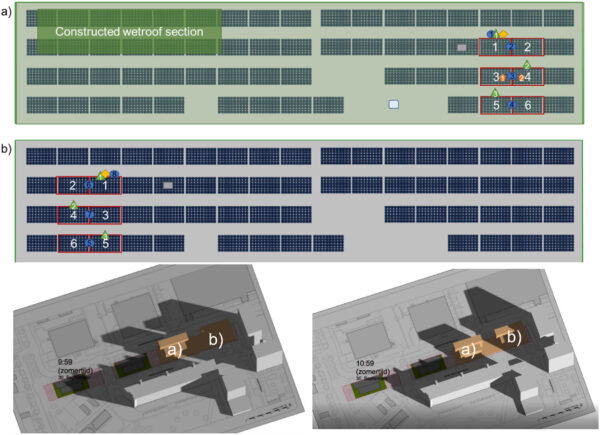A research group led by the Netherlands' KWR Water Research Institute has investigated how a blue-green roof (BGR) may act as a cooling agent for rooftop PV systems and has found that this kind of roof may lower the roof surface temperature by up to 4.64 C compared to a conventional bitumen roof (BiR).
Blue-green roofs are roofs that use “green” technologies, such as lateral drainage and irrigation for plant and crop growth, as well as “blue” technologies like rainwater storage and dosage.
The scientists conducted a series of tests on a PV system installed on a so-called constructed wetroof in an apartment building in Amsterdam. Constructed wetroofs are roofs that use natural processes involving wetland vegetation, soils, and their associated microbial assemblages to improve water quality. The irrigation system used for the research project relies on an additional water supply sourced from grey water from showers that is transformed into irrigation water.
The roof was also equipped with a Permavoid 85s rainwater retention system, a capillary irrigation system, and a substrate layer of 6 cm. “Using the treated grey water, the water level in the water storage layer below the vegetation is kept at a minimum of 50 mm, ensuring a sufficient water supply for the vegetation,” the Dutch group explained, adding that 26 native plant species native were sown on the roof's blankets.
The cooling performance of the BGR was compared to that of a BiR via a system of temperature sensors. Both roofs were equipped with 23.7 kW PV systems using 405 W panels from Chinese manufacturer JinkoSolar. The modules were arranged in a south-facing landscape position with a tilt angle of 20 degrees.

Image: Water Research Institute, Building and Environment, Creative Commons License CC BY 4.0
“The panels for detailed monitoring were chosen such that the panels on the blue-green and bitumen roofs are as close together as possible, yet the panels closest to the roof edge are excluded from the study as they will be influenced more by i.e. wind effects and less by vegetation,” the researchers stated.
Popular content
Through their analysis, the academics found that when temperatures were over 10 C the solar array on the BGR produced more power and a higher energy yield of up to 4.4% at similar irradiance compared to the BiR.
They also noted that the BGR is more exposed to sunlight due to its position. “That means that our results could be on the conservative side, so with similar shadow effects, the BGR could possibly perform even better than measured here,” they stated.
The group's findings were presented in the paper “Increasing solar panel output with blue-green roofs in water-circular and nature inclusive urban development,” which was recently published in Building and Environment.
“Overall, we have shown that a blue-green PV roof creates a win-win-win situation both for PV production, the local water balance as well as biodiversity,” the scientists concluded. “Future research could better investigate wind and albedo effects, different heights of solar panels above the roof and development of the vegetation and the effects of this changing vegetation on PV output.”
This content is protected by copyright and may not be reused. If you want to cooperate with us and would like to reuse some of our content, please contact: editors@pv-magazine.com.



1 comment
By submitting this form you agree to pv magazine using your data for the purposes of publishing your comment.
Your personal data will only be disclosed or otherwise transmitted to third parties for the purposes of spam filtering or if this is necessary for technical maintenance of the website. Any other transfer to third parties will not take place unless this is justified on the basis of applicable data protection regulations or if pv magazine is legally obliged to do so.
You may revoke this consent at any time with effect for the future, in which case your personal data will be deleted immediately. Otherwise, your data will be deleted if pv magazine has processed your request or the purpose of data storage is fulfilled.
Further information on data privacy can be found in our Data Protection Policy.